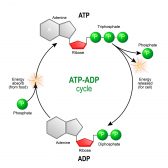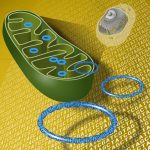Table of Contents
Definition
noun
plural: adenosines
a·den·o·sine, əˈdɛn əˌsin
A purine nucleoside that has adenine bound to a ribose sugar (ribofuranose) by a glycosidic bond
Details
Overview
A nucleoside is a nucleobase with a five-carbon sugar (either ribose or deoxyribose). It is a glycoside formed from the hydrolysis of nucleic acid. A purine nucleoside is one in which the nucleobase is a purine, such as adenine in adenosine. Adenosine is a nucleoside consisting of adenine and ribose sugar linked by β-N9-glycosidic bond. When a phosphate group is covalently attached to the sugar, it forms a nucleotide. In this case, the nucleotide of adenosine with phosphate group is exemplified by adenosine triphosphate (ATP), the energy-rich molecule that drives various metabolic processes.
Characteristics
Adenosine is found in all living organisms as a structural component of important nucleic acids. It may also be prepared as a medication for treating certain supraventricular tachycardia. As a pharmaceutical drug, it is administered via IV. It has a short half-life (<10 seconds) as it is rapidly taken up by the cells and converted into inosine and adenosine monophosphate. It can also leave the cell as is or it can be degraded into xanthine or hypoxanthine, which in turn is degraded into uric acid.
The chemical formula of adenosine is C10H13N5O4. Its molar mass is 267.241 g/mol.
Adenosine vs. Deoxyadenosine
Nucleosides may be classified into ribonucleosides or deoxyribonucleosides, depending on the sugar component. Adenosine is a ribonucleoside due to its ribose sugar. In contrast, deoxyadenosine is a deoxyribonucleoside for having a sugar component that is deoxyribose. Deoxyadenosine differs from adenosine by having a hydroxyl group replaced by hydrogen at the 2′ position of the sugar moiety. Deoxyadenosine pairs up with deoxythymidine in DNA whereas adenosine pairs with thymidine in RNA.
Adenosine receptors
Adenosine receptors are a class of purinergic G protein-coupled receptors in which the endogenous ligand is adenosine. As one of the agonists, adenosine activates these receptors. In humans, there are four known types of adenosine receptors: A1, A2A, A2B, and A3. These receptors have varying physiological functions. The physiological role of A1, in particular, is to decreased heart rate. In the brain, it slows metabolic activity. A2A is involved in the vasodilation of the coronary artery, decreasing dopaminergic activity of the central nervous system, and inhibiting central neuron excitation. A2B induces bronchospasm. The effects of A3 are the relaxation of the cardiac muscle, the contraction of smooth muscle, and inhibition of neutrophil degranulation. Known antagonists of these receptors are coffee and chocolate.
Common biological reactions
Common biological reactions
Nucleosides such as adenosine can be produced by de novo synthesis pathways in the liver. Nevertheless, they may also be obtained from the diet. When the diet contains nucleotides, the body digests them by nucleotidases to produce nucleosides and phosphates. Nucleosides are degraded into their subcomponents (i.e. nucleobases and sugar) by the action of nucleosidases in the lumen of the digestive tract.
Biological functions
Adenosine, just as the other nucleosides, can give rise to nucleotides. When phosphorylated by kinases, the nucleoside is converted into a nucleotide. Thus, a nucleotide is a nucleoside with a phosphate group. Adenosine can form adenosine monophosphate (AMP, i.e. adenosine with a single phosphate group), adenosine diphosphate (ADP, i.e. adenosine with two phosphate groups), and adenosine triphosphate (ATP, i.e. adenosine with three phosphate groups). ATP, in particular, is an energy-rich molecule produced chiefly via cellular respiration.
Being a major molecular component of ATP, ADP, and AMP, adenosine is, thus, involved in various physiologic processes such as energy transfer (e.g. as ATP) and signal transduction (i.e. as cAMP). In the brain, adenosine acts as an inhibitory neurotransmitter. It can promote sleep as well as suppress arousal. Thus, adenosine has an inhibitory effect in the central nervous system. Caffeine is an antagonist of the adenosine receptors in the brain. It blocks these receptors and therefore adenosine cannot establish its effect.
In the heart, adenosine causes dilation of coronary blood vessels and blood vessels in the peripheral organs. Thus, it helps improve blood circulation. However, in the kidneys, adenosine decreases renal blood flow while decreasing the production of rennin. In the lungs, it causes the constriction of the airways and the blood vessels in the liver. It is involved as well in the glycogenolysis, i.e. the process of breaking down glycogen into glucose.1
Pharmaceutical use
The pharmacologic action of adenosine includes vasodilation, anti-arrhythmia, and analgesia. When given intravenously, adenosine can cause transient heart block in the AV node. Intramuscularly, adenosine phosphate is used to treat bursitis, tendonitis, varicose veins, itchiness, multiple sclerosis, cold sores, genital herpes, etc.
AMP, in particular, is given orally to treat shingles. It is also used to treat porphyria cutanea tarda (a type of blood disorder). ATP as a medication to treat acute kidney failure, pulmonary hypertension, multiple organ failure, cystic fibrosis, etc.
Supplementary
Etymology
- From German adenosin, combination of aden(ine) + (rib)os(e) + –ine
IUPAC
Chemical formula
- C10H13N5O4
Synonym(s)
Derived term(s)
Further reading
See also
- nucleoside
- deoxyadenosine
Reference
- Mandal, A. (2019, February 26). What is Adenosine? Retrieved from News-Medical.net website: ://www.news-medical.net/health/What-is-Adenosine.aspx Link
© Biology Online. Content provided and moderated by Biology Online Editors







